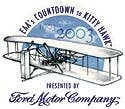
A month after receiving pamphlets and a list of books on human flight from the Smithsonian Institution, Wilbur and Orville Wright were already at work attempting to build a flying machine of their own. It was not a full-sized glider but rather a small biplane with a five-foot wingspan that was to be flown like a kite. The cloth-covered wings, shellacked to make them airtight, were trussed with wire from side to side. The connecting uprights were hinged, so the upper wing could be moved forward or backward to control the vertical upward or downward movement of the machine.
Lateral control, the kind exercised by a bird to turn or change direction, was another matter. In airplanes today, it is achieved by moving the ailerons on the trailing edges of the two wings in opposite directions. The fact that an aircraft alters the angles of its wings in order to turn or restore balance is fairly obvious today … but it was not so in 1899.
|| |---| | | | Orville Wright demonstrates wing-warping with the 1910 Flyer.| According to Wilbur, the Wrights discovered the birds' method of lateral control one day while observing a flight of pigeons. When a bird wanted to change direction, first one wing would go high, then the other. What the brothers realized was that, to execute a particular maneuver, the birds curved their wingtips at opposite angles, and then when they had turned or righted themselves as much as they wished, reversed the process to maintain balance or go the other way. "Thus the balance," Wilbur explained, "was controlled by utilizing dynamic reactions of the air instead of shifting weight."
Having grasped the concept, the Wrights remained puzzled as to how to attain it. During the summer of 1899, Wilbur stumbled onto the solution while working at the bicycle shop. While selling an inner tube to a customer, Wilbur removed the tube from its long, narrow box, and, as they chatted, he began to absentmindedly twist the ends of the box in opposite directions. As he did so, he suddenly visualized the box as a biplane, with the top wing connected to the bottom wing by the sides of the box. By twisting the corners of the wings in different directions-just as the pigeons did-he reasoned that lateral control could be maintained. That night, when he showed the box to Orville, his brother agreed, and they decided to use this "wing-warping" principle in their new glider, using a series of warping wires that ran through pulleys to the wingtips. A major problem in achieving controlled flight had been overcome.
This "Kitty Hawk Moment" is brought to you by the EAA, whose Countdown to Kitty Hawk program, presented by Ford Motor Company, includes an exact flying reproduction of the Wright Flyer. It is the centerpiece of the EAA's national tour during 2003, which will conclude with a five-day celebration at Kitty Hawk, North Carolina, where the Wright Flyer will fly again at exactly 10:35 a.m. on December 17, 2003, commemorating 100 years of powered flight.
www.countdowntokittyhawk.org

Sign-up for newsletters & special offers!
Get the latest FLYING stories & special offers delivered directly to your inbox






